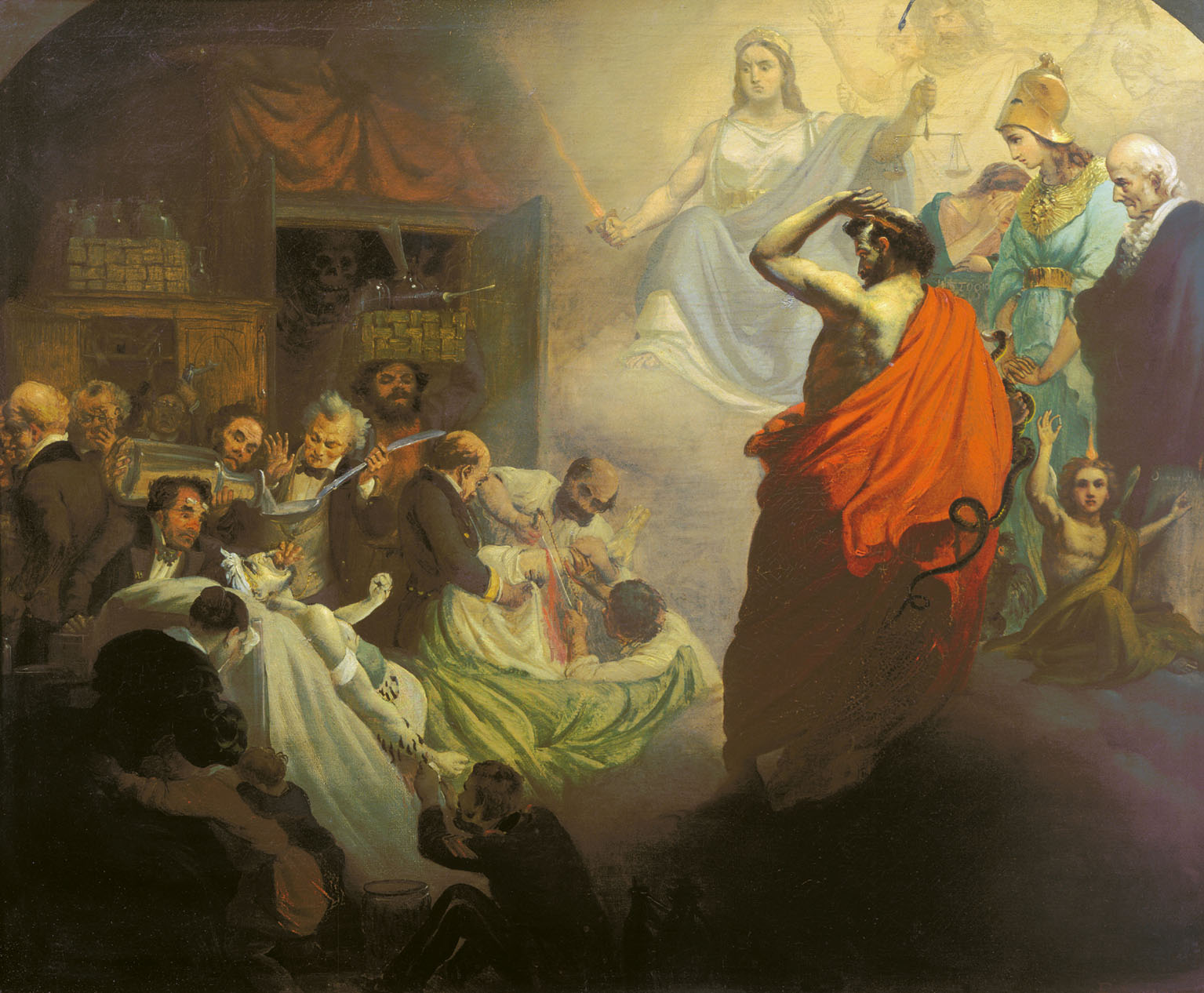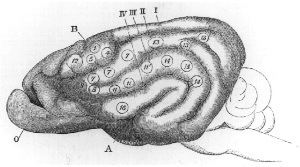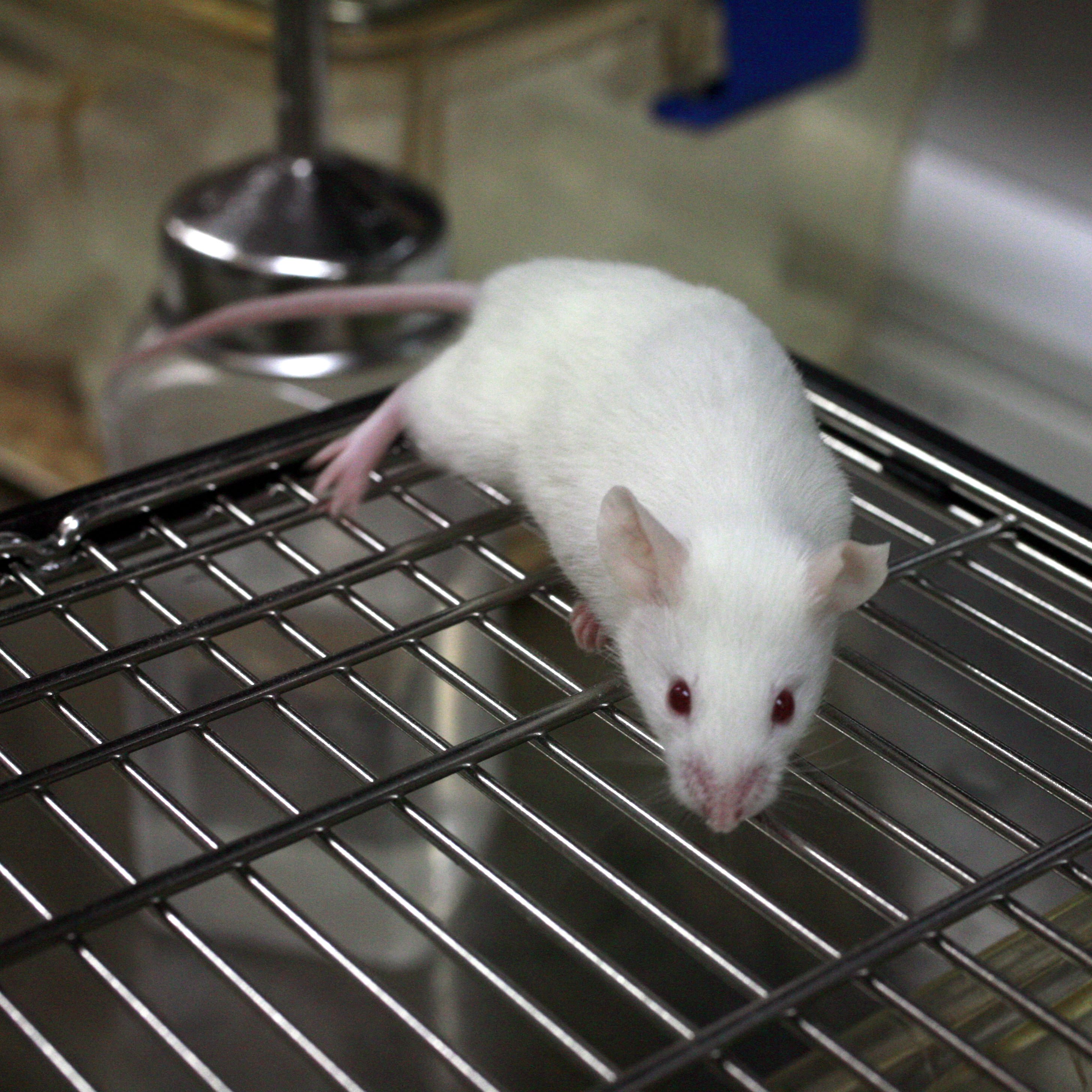|
Roberts Bartholow
Roberts Bartholow or Roobert Bartholow (November 28, 1831 – May 10, 1904) was an American physician and a professor at several American medical colleges. He is best known for his experiments involving a 30-year-old patient named Mary Rafferty. Rafferty was admitted to Good Samaritan Hospital in Cincinnati, Ohio in 1874 with a 2-inch-diameter (51 mm) hole in her skull caused by a cancerous ulcer. Bartholow experimented with applying current to Rafferty's exposed dura using needle electrodes. His report detailed the first observations of how electrical stimulation of the brain affects motor functions of the body, but many ethical concerns were raised about the way in which he carried out his experiments. Rafferty went into a coma for three days and then died the day after coming out of the coma from a massive seizure. Education and career Roberts Bartholow was born in New Windsor, Maryland. He attended Calvert College in his hometown, and graduated in 1848 with a Bachel ... [...More Info...] [...Related Items...] OR: [Wikipedia] [Google] [Baidu] |
New Windsor, Maryland
New Windsor is a town in Carroll County, Maryland, United States. The population was 1,441 at the 2020 census. The town is known for having been the residence of Abstract Expressionist painter Clyfford Still during the mid to late 20th century. History New Windsor was platted in 1797 and originally named Sulphur Springs, for a local spring with water believed to have medicinal properties. It was given its current name in the early 19th century, possibly after its English namesake. The town was originally founded to service and profit from junctures of wagon trails in the area, but would later become a destination in and of itself because of the sulfur springs. To capitalize from the visitors to the springs, the town would become home to a bathhouse and numerous inns, including the 10,000+ square foot Dielman Inn. New Windsor became home to Calvert College in 1850, to later become the New Windsor College in 1872, and then finally a campus of Blue Ridge College in 1912 until 19 ... [...More Info...] [...Related Items...] OR: [Wikipedia] [Google] [Baidu] |
Allopathic Medicine
Allopathic medicine, or allopathy, is an archaic and derogatory label originally used by 19th-century homeopaths to describe heroic medicine, the precursor of modern evidence-based medicine. Citing: ''Gale Encyclopedia of Medicine'' (2008) and ''Mosby's Medical Dictionary'', 8th ed. (2009). There are regional variations in usage of the term. In the United States, the term is sometimes used to contrast with osteopathic medicine, especially in the field of medical education. In India, the term is used to distinguish conventional modern medicine from Siddha medicine, Ayurveda, homeopathy, Unani and other alternative and traditional medicine traditions, especially when comparing treatments and drugs. The terms were coined in 1810 by the creator of homeopathy, Samuel Hahnemann. Heroic medicine was the conventional European medicine of the time and did not rely on evidence of effectiveness. It was based on the belief that disease is caused by an imbalance of the four " humours" (b ... [...More Info...] [...Related Items...] OR: [Wikipedia] [Google] [Baidu] |
Bioethicist
Bioethics is both a field of study and professional practice, interested in ethics, ethical issues related to health (primarily focused on the human, but also increasingly includes animal ethics), including those emerging from advances in biology, medicine, and technologies. It proposes the discussion about moral discernment in society (what decisions are "good" or "bad" and why) and it is often related to medical policy and practice, but also to broader questions as Biophysical environment, environment, well-being and public health. Bioethics is concerned with the ethical questions that arise in the relationships among life sciences, biotechnology, medicine, politics, law, theology and philosophy. It includes the study of values relating to primary care, other branches of medicine ("primary care ethics, the ethics of the ordinary"), ethical education in science, animal, and environmental ethics, and public health. Etymology The term ''bioethics'' (Greek language, Greek , "life" ... [...More Info...] [...Related Items...] OR: [Wikipedia] [Google] [Baidu] |
Eduard Hitzig
Eduard Hitzig (6 February 1838 – 20 August 1907) was a German neurologist and neuropsychiatrist of Jewish ancestryAndrew P. Wickens, ''A History of the Brain: From Stone Age Surgery to Modern Neuroscience'', Psychology Press (2014), p. 226 born in Berlin. Eduard was the son of Friedrich Hitzig and his grandfather had converted to Protestantism. He studied medicine at the Universities of Berlin and Würzburg under the instruction of famous men such as Emil Du Bois-Reymond (1818–1896), Rudolf Virchow (1821–1902), Moritz Heinrich Romberg (1795–1873), and Karl Friedrich Otto Westphal (1833–1890). He received his doctorate in 1862 and subsequently worked in Berlin and Würzburg. In 1875, he became director of the Burghölzli asylum, as well as professor of psychiatry at the University of Zurich. In 1885, Hitzig became a professor at the University of Halle where he remained until his retirement in 1903. Hitzig is remembered for his work concerning the interaction ... [...More Info...] [...Related Items...] OR: [Wikipedia] [Google] [Baidu] |
Gustav Fritsch
Gustav Theodor Fritsch (5 March 1838 – 12 June 1927) was a German anatomist, anthropologist, traveller and physiologist from Cottbus. Fritsch studied natural science and medicine in Berlin, Breslau and Heidelberg. In 1874 he became an associate professor of physiology at the University of Berlin, where he was later appointed head of the histology, histological department at the physiological institute. He is known for his work with neuropsychiatrist Eduard Hitzig (1839–1907) involving the localization of brain function, localization of the motor areas of cerebral cortex, motor areas of the brain. In 1870, the two scientists probed the cerebral cortex of a dog to discover that electrical stimulation of different areas of the cerebrum caused involuntary muscular contractions of specific parts of the dog's body. Along with his medical studies, Fritsch was also known for his ethnography, ethnographical research in southern Africa (1863–66), during which time he traveled fr ... [...More Info...] [...Related Items...] OR: [Wikipedia] [Google] [Baidu] |
Epithelioma
Epithelioma is an tumor, abnormal growth of the epithelium, which is the layer of tissue that covers the surfaces of organs and other structures of the body. Classification Epitheliomas can be benign growths or carcinoma, malignant carcinomas. They are classified according to the specific type of epithelial cells that are affected. The most common epitheliomas are basal cell carcinoma and squamous cell carcinoma (skin cancers). Treatment Treatment usually involves surgically removing the tumor and affected tissue. Cryosurgery or radiotherapy may also be used. Prognosis The prognosis varies dramatically, depending on the type and stage at the time of treatment. However, the most common epitheliomas are very easily treated and rarely result in death. The condition did, however, take the life of Scottish golfer Willie Dunn Sr., Willie Dunn, Sr. in 1878 at a time when the ailment was likely not fully understood. See also * Mule spinners' cancer References External links [...More Info...] [...Related Items...] OR: [Wikipedia] [Google] [Baidu] |
American Neurological Association
The American Neurological Association (ANA) is a professional society of academic neurologists and neuroscientists devoted to advancing the goals of academic neurology; to training and educating neurologists and other physicians in the neurologic sciences; and to expanding both our understanding of diseases of the nervous system and our ability to treat them. It was founded in June 1875. See also * American Medical Association * American Psychiatric Association The American Psychiatric Association (APA) is the main professional organization of psychiatrists and trainee psychiatrists in the United States, and the largest psychiatric organization in the world. It has more than 39,200 members who are in ... * Transactions of the American Neurological Association * Sarah McNutt References External links * Medical associations based in the United States Neurology organizations Organizations established in 1875 Medical and health organizations based in New Jers ... [...More Info...] [...Related Items...] OR: [Wikipedia] [Google] [Baidu] |
David Ferrier
Sir David Ferrier FRS (13 January 1843 – 19 March 1928) was a pioneering Scottish neurologist and psychologist. Ferrier conducted experiments on the brains of animals such as monkeys and in 1881 became the first scientist to be prosecuted under the Cruelty to Animals Act, 1876 which had been enacted following a major public debate over vivisection. Life Ferrier was born in Woodside, Aberdeen, the sixth child of David and Hannah; he was educated at Aberdeen Grammar School before studying for an MA at Aberdeen University (graduating in Classics in 1863), before studying psychophysiology in Germany and medicine at Edinburgh. As a medical student, he began to work as a scientific assistant to the influential free-thinking philosopher and psychologist Alexander Bain (1818–1903), one of the founders of associative psychology. Around 1860, psychology was finding its scientific foundation mainly in Germany, with the rigorous research of Hermann von Helmholtz (1821–1 ... [...More Info...] [...Related Items...] OR: [Wikipedia] [Google] [Baidu] |
Anti-vivisectionism
Vivisection () is surgery conducted for experimental purposes on a living organism, typically animals with a central nervous system, to view living internal structure. The word is, more broadly, used as a pejorative catch-all term for experimentation on live animalsTansey, E.MReview of ''Vivisection in Historical Perspective'' by Nicholaas A. Rupke, book reviews, National Center for Biotechnology Information, p. 226. by organizations opposed to animal experimentation,Yarri, Donna''The Ethics of Animal Experimentation: A Critical Analysis and Constructive Christian Proposal'', Oxford University Press, 2005, p. 163. but the term is rarely used by practicing scientists. Human vivisection, such as live organ harvesting, has been perpetrated as a form of torture. Animal vivisection Regulations and laws Research requiring vivisection techniques that cannot be met through other means is often subject to an external ethics review in conception and implementation, and in many jurisd ... [...More Info...] [...Related Items...] OR: [Wikipedia] [Google] [Baidu] |
American Philosophical Society
The American Philosophical Society (APS) is an American scholarly organization and learned society founded in 1743 in Philadelphia that promotes knowledge in the humanities and natural sciences through research, professional meetings, publications, source text, library resources, and community outreach. It was founded by the polymath Benjamin Franklin and is considered the first learned society founded in what became the United States.Philosophical Hall, the society's headquarters and a museum, is located just east of Independence Hall in Independence National Historical Park. In 1965, in recognition of the building's history, it was designated a National Historic Landmark. The society has about 1,000 elected members. As of April 2020, 5,710 members had been inducted since its creation. Through research grants, published journals, the American Philosophical Society Museum, an extensive library, and regular meetings, the society supports a variety of disciplines in the humanitie ... [...More Info...] [...Related Items...] OR: [Wikipedia] [Google] [Baidu] |
Philadelphia
Philadelphia ( ), colloquially referred to as Philly, is the List of municipalities in Pennsylvania, most populous city in the U.S. state of Pennsylvania and the List of United States cities by population, sixth-most populous city in the United States, with a population of 1,603,797 in the 2020 United States census, 2020 census. The city is the urban core of the Philadelphia metropolitan area (sometimes called the Delaware Valley), the nation's Metropolitan statistical area, seventh-largest metropolitan area and ninth-largest combined statistical area with 6.245 million residents and 7.379 million residents, respectively. Philadelphia was founded in 1682 by William Penn, an English Americans, English Quakers, Quaker and advocate of Freedom of religion, religious freedom, and served as the capital of the Colonial history of the United States, colonial era Province of Pennsylvania. It then played a historic and vital role during the American Revolution and American Revolutionary ... [...More Info...] [...Related Items...] OR: [Wikipedia] [Google] [Baidu] |
Jefferson Medical College
Thomas Jefferson University is a private research university in Philadelphia, Pennsylvania, United States. Established in its earliest form in 1824, the university officially combined with Philadelphia University in 2017. The university is named for U.S. Founding Father and president Thomas Jefferson. It is classified among "R2: Doctoral Universities – High research activity". To signify its heritage, the university sometimes carries the nomenclature ''Jefferson (Philadelphia University + Thomas Jefferson University)'' in its branding. History Philadelphia University Philadelphia University was originally known as Philadelphia Textile School when it was founded in 1884, and then Philadelphia Textile Institute for 20 years (1942–1961), Philadelphia College of Textiles & Science for 38 years (1962–1999), and Philadelphia University for 18 years (1999–2017), its final name before merger with Thomas Jefferson University. At the 1876 Centennial Exposition, local texti ... [...More Info...] [...Related Items...] OR: [Wikipedia] [Google] [Baidu] |






